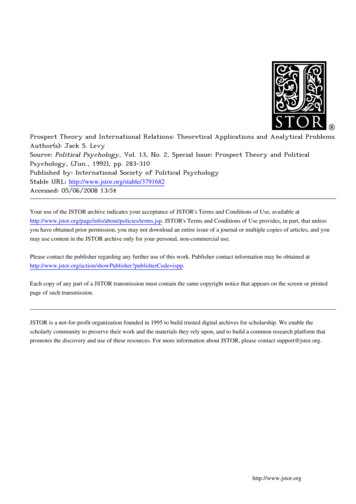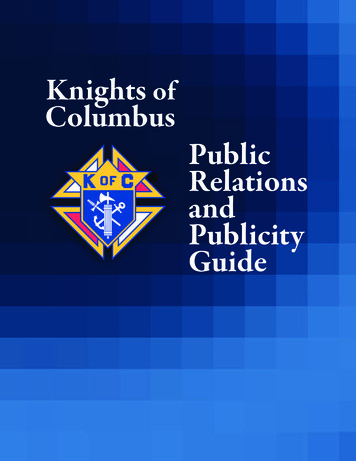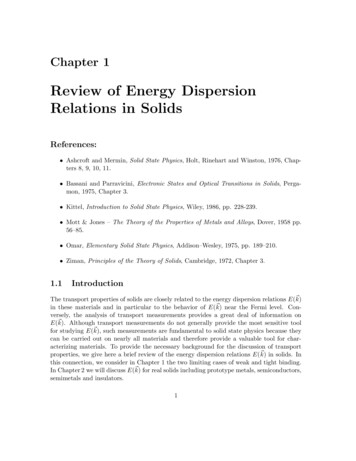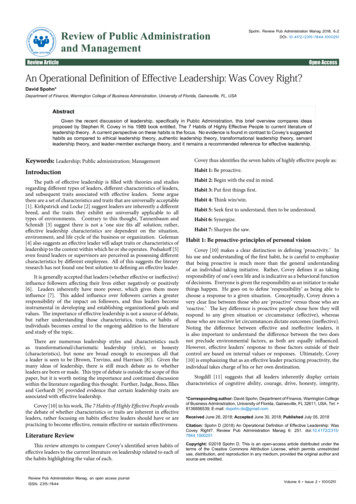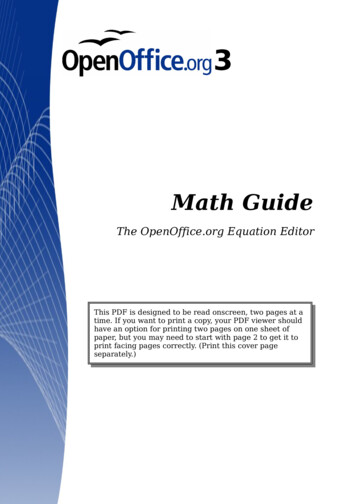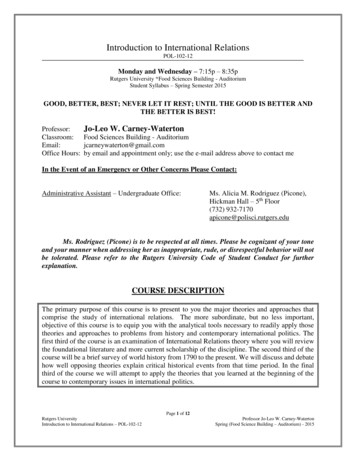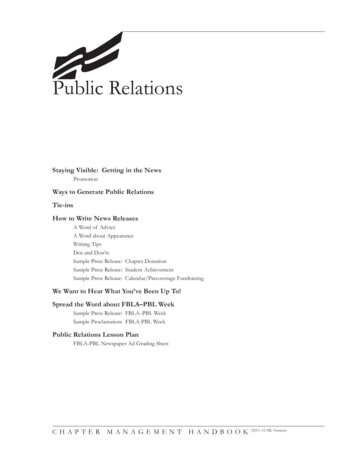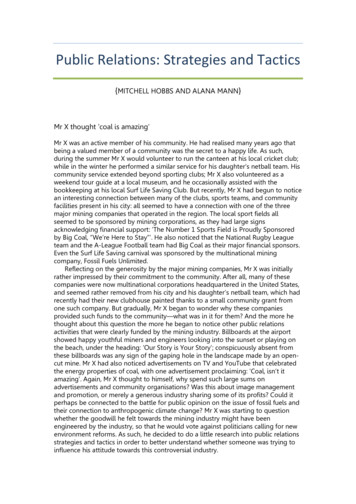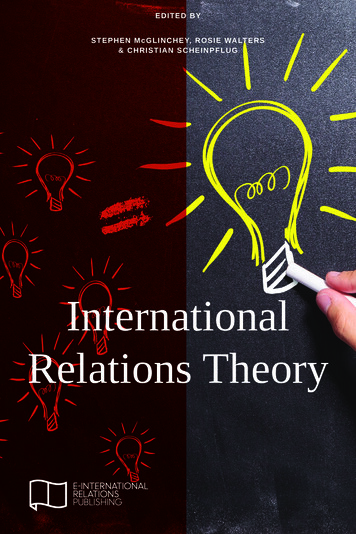
Transcription
E D IT E D B YS T EP H E N Mc GL IN C H EY, R OSIE WA LTE R S& C H R IS T IA N SC H E IN P FLU G iInternationalRelations Theory
This e-book is provided without charge via free download by E-InternationalRelations (www.E-IR.info). It is not permitted to be sold in electronic formatunder any circumstances.If you enjoy our free e-books, please consider leaving a small donation toallow us to continue investing in open access publications:http://www.e-ir.info/about/donate/
i“In the plethora of textbooks on IR almost none depart from ‘playing it safe’,giving forms of instruction in the rudiments of established theories. The greatbreakout of this volume is its entire second half of proposing quite radical newways of looking at the world. The book is both ‘safe’ and ‘unsafe’ and in bothit is sometimes witty in a way that students will savour – learning what IR is,and what it could be. A lovely book in which even the doyens of ‘old’ IR aresometimes bold.”– Stephen Chan OBE, Professor of World Politics, School of Oriental &African Studies, University of London.“This rich volume offers a highly accessible and exceptionally broad-rangingintroduction to the field of International Relations theory. In 20 short chaptersthe book provides a highly readable and comprehensive overview of coretheoretical frameworks ranging from ‘mainstream’ realism and liberalism allthe way to queer theory and critical geography. By placing each theory incontext, and by providing a wealth of easily graspable examples, the bookprovides ‘one-stop shopping’ for the full range of theoretical frameworks andconcepts – along with welcome attention to non-western perspectives. Anexcellent place to start.”– Mette Eilstrup-Sangiovanni, Senior University Lecturer in InternationalRelations at Cambridge University.“This is a superb book. It offers a comprehensive listing that is imaginativelypresented and enormously accessible. Helpfully, too, it takes the form of aglobal conversation. IR theory at its sparkling best.”– Peter Vale, Professor of Humanities, University of Johannesburg; Professorof Public Policy and Global Affairs, Nanyang Technological University andNelson Mandela Professor of Politics Emeritus, Rhodes University.
iiInternationalRelations TheoryED IT ED BYS T E PH EN M C GL IN C H EY, R OS IE WA LTE R S& C H R IS T IAN SC H E INP FLU G
iiiE-International Relationswww.E-IR.infoBristol, England2017ISBN 978-1-910814-19-2 (paperback)ISBN 978-1-910814-20-8 (e-book)This book is published under a Creative Commons CC BY-NC 4.0 license. Youare free to: Share – copy and redistribute the material in any medium or formatAdapt – remix, transform, and build upon the materialUnder the following terms: Attribution – You must give appropriate credit, provide a link to thelicense, and indicate if changes were made. You may do so in anyreasonable manner, but not in any way that suggests the licensorendorses you or your use.Non-Commercial – You may not use the material for commercialpurposes.Any of the above conditions can be waived if you get permission. Pleasecontact info@e-ir.info for any such enquiries, including for licensing andtranslation requests.Other than the terms noted above, there are no restrictions placed on the useand dissemination of this book for student learning materials/scholarly use.Production: Michael TangCopy-editing: Gill GairdnerCover Image: feedough via DepositphotosA catalogue record for this book is available from the British Library.
ivE-IR FoundationsSeries Editor: Stephen McGlincheyEditorial Assistants: Michael Bolt, Eloise Cox, Gary Leigh and Farah Saleem.E-IR Foundations is a series of beginner’s textbooks from E-InternationalRelations (E-IR) that are designed to introduce complicated issues in apractical and accessible way. Each book will cover a different area connectedto International Relations. This is the second book in the series, with more tofollow.You can find the books, and many other learning materials, on E-IR’s StudentPortal: http://www.e-ir.info/studentsE-IR is developing our Foundations series as part of our mission to providethe best source of freely available scholarly materials for students ofInternational Relations. Each book is available to buy in bookstores inpaperback and, uniquely for textbooks, also freely accessible in web and PDFformats. So, readers can have each book at their fingertips and on all theirdevices without any restrictions or hassle.Typically, textbook publishing is designed to appeal to professors/lecturersand, consequently, even the introductory books are intended less as an aid tothe student and more to assist the instructor in the classroom. Our books aredesigned to meet the needs of the student, with the focus on moving readersfrom no prior knowledge to competency. They are intended to accompany,rather than replace, other texts, while offering the student a fresh perspective.About E-International RelationsE-International Relations is the world’s leading open access website forstudents and scholars of international politics, reaching over three millionreaders per year. E-IR’s daily publications feature expert articles, blogs,reviews and interviews – as well as student learning resources. The websiteis run by a non-profit organisation based in Bristol, UK and staffed by an allvolunteer team of students and scholars.http://www.e-ir.info
vAcknowledgementsThis book would not have been possible without the assistance of E-IR’sStudent Review Panel. Members of the panel gave up their spare time to readdrafts of each chapter and offer their thoughts on how they could beimproved. The panel comprised Laura Southgate, Matthew Koo, ConstanceDijkstra, Loveleena Sharma, Daniel Golebiewski, Ljupcho Stojkovski, MaxNurnus, Jess Dam, Caroline Cottet, Jan Tattenberg, Matthew Ribar, LauraCartner, Cameran Clayton, Phoebe Gardner, Ana Carolina Sarmento, NaomiMcMillen, Kanica Rakhra, Dean Cooper-Cunningham, Jonathan Webb, DanielRowney, Janja R. Avgustin and Scott Edwards.The editors would also like to thank all members of the E-InternationalRelations team, past and present, for their many acts of kindness in feedingback on ideas and providing a supportive climate for the book’s development.Finally, and most importantly, the editors would like to thank the authors ofeach of the chapters for working so hard on this project and helping us deliversuch an excellent book.
vi
viiInternational Relations TheoryContentsGETTING STARTED WITH INTERNATIONAL RELATIONS THEORYStephen McGlinchey, Rosie Walters & Dana Gold 1PART ONE – ESTABLISHED THEORIES1.REALISMSandrina Antunes & Isabel Camisão 15LIBERALISMJeffrey W. Meiser 22THE ENGLISH SCHOOLYannis A. Stivachtis28CONSTRUCTIVISMSarina Theys36MARXISMMaïa Pal42CRITICAL THEORYMarcos Farias Ferreira49POSTSTRUCTURALISMAishling Mc Morrow56FEMINISMSarah Smith62POSTCOLONIALISMSheila Nair6910. TOWARDS A GLOBAL IR?Amitav Acharya762.3.4.5.6.7.8.9.
ContentsviiiPART TWO – EXPANSION PACK11. GREEN THEORYHugh C. Dyer8412. GLOBAL JUSTICEAlix Dietzel9113. QUEER THEORYMarkus Thiel9714. SECURITISATION THEORYClara Eroukhmanoff10415. CRITICAL GEOGRAPHYIrena Leisbet Ceridwen Connon & Archie W. Simpson11016. ASIAN PERSPECTIVESPichamon Yeophantong11717. GLOBAL SOUTH PERSPECTIVESLina Benabdallah, Victor Adetula & Carlos Murillo-Zamora12518. INDIGENOUS PERSPECTIVESJeff Corntassel & Marc Woons13119. A CONTEMPORARY PERSPECTIVE ON REALISMFelix Rösch & Richard Ned Lebow13820. THE ‘ISMS’ ARE EVIL. ALL HAIL THE ‘ISMS’!Alex Prichard145REFERENCES 153NOTE ON INDEXING 166
ixInternational Relations TheoryContributorsVictor Adetula is Head of Research at the Nordic Africa Institute, Uppsala,Sweden and Professor of International Relations and Development Studies atthe University of Jos, Nigeria.Amitav Acharya is Distinguished Professor of International Relations and theUNESCO Chair in Transnational Challenges and Governance at AmericanUniversity, USA.Sandrina Antunes is an Assistant Professor at the Department of InternationalRelations and Public Administration at the Universidade do Minho, Portugaland a Scientific Fellow at the Center for the Study of Politics, Université Librede Bruxelles, Belgium.Lina Benabdallah is an Assistant Professor of Political Science at WakeForest University, USA.Isabel Camisão is an Assistant Professor of International Relations at theUniversity of Évora, Portugal.Irena Leisbet Ceridwen Connon is a Postdoctoral Research Fellow in HumanGeography at the University of Dundee, UK.Jeff Corntassel is an Associate Professor and Director of IndigenousGovernance at the University of Victoria, Canada. He is a citizen of theCherokee Nation.Alix Dietzel is a Lecturer in Global Ethics at the University of Bristol, UK.Hugh C. Dyer is an Associate Professor of World Politics at the University ofLeeds, UK.Clara Eroukhmanoff is a Lecturer in International Relations at London SouthBank University, UK.
ContributorsxMarcos Farias Ferreira is a Lecturer in International Relations at theUniversity of Lisbon and Instituto Universitário de Lisboa (ISCTE-IUL), Centrode Estudos Internacionais, Portugal.Dana Gold is a PhD candidate at the University of Western Ontario inLondon, Canada.Richard Ned Lebow is a Professor of International Political Theory at King’sCollege London, UK, Bye-Fellow of Pembroke College, University ofCambridge, UK and the James O. Freedman Presidential Professor(Emeritus) of Government at Dartmouth College, USA.Stephen McGlinchey is Senior Lecturer in International Relations at theUniversity of the West of England, Bristol and Editor-in-Chief ofE-International Relations.Aishling Mc Morrow is a Lecturer in International Relations at Queen’sUniversity Belfast, UK.Jeffrey W. Meiser is an Assistant Professor in Political Science at theUniversity of Portland, USA.Carlos Murillo-Zamora is a Professor at the University of Costa Rica and theNational University of Costa Rica.Sheila Nair is Professor of Politics and International Affairs at NorthernArizona University, USA.Maïa Pal is a Senior Lecturer in International Relations at Oxford BrookesUniversity, UK.Alex Prichard is a Senior Lecturer in International Relations at the Universityof Exeter, UK.Felix Rösch is a Senior Lecturer in International Relations at CoventryUniversity, UK.Christian Scheinpflug is Lead Editor of E-International Relations and acolumnist at the Santiago Times.
xiInternational Relations TheoryArchie W. Simpson is a Teaching Fellow in Politics and International Relationsat the University of Bath, UK.Sarah Smith is visiting Assistant Professor in Gender Studies at CentralEuropean University, Budapest. She has also held lecturing posts at MonashUniversity, Swinburne University of Technology and Australian CatholicUniversity, Melbourne.Yannis A. Stivachtis is an Associate Professor of Political Science andDirector of the International Studies Program at Virginia Tech, USA.Sarina Theys is a Contributing Lecturer in the Politics Department ofNewcastle University, UK.Markus Thiel is an Associate Professor of Politics & International Relationsand Director of the EU/Jean Monnet Center of Excellence at FloridaInternational University, USA.Rosie Walters is a PhD candidate at the University of Bristol, UK and anEditor-at-Large of E-International Relations.Marc Woons is a Doctoral Fellow with the Fonds WetenschappelijkOnderzoek – Vlaanderen (Research Foundation – Flanders) and theResearch in Political Philosophy Leuven (RIPPLE) Institute at the Universityof Leuven in Belgium.Pichamon Yeophantong is a Lecturer in International Relations andDevelopment at the University of New South Wales (UNSW Sydney),Australia.
1International Relations TheoryGetting Started withInternational Relations TheoryS T E P HE N M C GL IN C H E Y, R OSIE WALTE R S & D A N A GOLDBefore we go forward you should know that this book is available in e-book,PDF, web and paperback versions. While we know that many will use thedigital versions of the book, we encourage you to buy a paperback copy aswell if you are able. A growing body of research offers strong evidence that itis more effective to study from paper sources than from digital. Regardless ofhow you engage with the book, we hope it is an enjoyable read.You can order the paperback version of this book in all good bookstores –from Amazon right down to your local bookstore – and digital versions arealways freely available on the E-International Relations Students Portal:http://www.e-ir.info/students/The Students Portal also includes a range of online resources thatcomplement and expand upon the material in this book: http://www.e-ir.info/online-resources/HelloThis book is designed as a foundational entry point to International Relations(IR) theory. As a beginner’s guide, it has been structured to condense themost important information into the smallest space and present thatinformation in the most accessible manner in order to introduce this area ofstudy in a fresh way. It is recommended that you first consult this book’scompanion text International Relations (McGlinchey 2017) so that you have afuller understanding of the discipline of International Relations before youdelve into IR theory, which is one of its more difficult elements.Theories of IR allow us to understand and try to make sense of the worldaround us through various lenses, each of which represents a differenttheoretical perspective. They are ways to simplify a complicated world. In a
Getting Started with International Relations Theory2familiar analogy, theories are like maps. Each map is made for a certainpurpose and what is included in the map is based on what is necessary todirect the map’s user. All other details are left out to avoid confusion andpresent a clear picture. Since a picture paints a thousand words, go toGoogle and type in ‘Singapore MRT’ and then click on images. There you willsee a map of Singapore’s Mass Rapid Transit network. Enlarge it and stare atit for a moment. What you see there are lines, stations and some basicaccess information. You will not see public toilets, roads, banks, shops (andthe like) charted as these are not essential to travelling on the system.Theories do a similar thing. Each different theory of IR puts different things onits map, based on what its theorists believe to be important. Variables to ploton an IR map would be such things as states, organisations, people,economics, history, ideas, class, gender and so on. Theorists then use theirchosen variables to construct a simplified view of the world that can be usedto analyse events – and in some cases to have a degree of predictive ability.In a practical sense, IR theories can be best seen as an analytical toolkit asthey provide multiple methods for students to use to answer questions.Some students love studying IR theories because they open up interestingquestions about the world we live in, our understanding of human nature andeven what it is possible to know. Some students, however, are eager to getstraight to the real-life (often described as ‘empirical’) case studies of worldevents that made them want to study IR in the first place. For these students,studying IR theory might even seem like a distraction. Yet it is crucial to pointout that embarking on the study of International Relations without anunderstanding of theory is like setting off on a journey without a map. Youmight arrive at your destination, or somewhere else very interesting, but youwill have no idea where you are or how you got there. And you will have noresponse to someone who insists that their route would have been muchbetter or more direct. Theories give us clarity and direction; they help us toboth defend our own arguments and better understand the arguments ofothers.This book presents a wide range of IR theories, split into two sections. Thefirst section covers the established theories that are most commonly taught inundergraduate IR programmes. The second section expands to presentemerging approaches and offer wider perspectives on IR theory. By givingequal space to the two sections we encourage readers to appreciate thediversity of IR theory. Each chapter of the book has a simple set of aims inmind. First, to compress and simplify the basics of each theory. Althoughtheories are complex, our aim with this book is to provide an accessiblefoundation for further study rather than try to survey an entire field ofscholarship. To return to the map analogy from above, our aim with eachchapter is to give you a starting point on your journey – you will have to read
3International Relations Theorydeeper and wider to fully appreciate each theory’s complexity. Like a goodmap, the chapters signpost you to where you can find this literature. Second,and to help you continue your journey in IR theory, each chapter alsopresents a case study of a real-world event or issue. This allows you to seeeach theory in action as a tool of analysis and understand the insights that IRtheory can bring. The final chapter of each of the two sections (chapters 10and 20) breaks this format and instead offers an innovative perspective on IRtheory as a whole – allowing you to take a fresh view of things and reflectback on the discipline as you reach the mid and end points of the book.Unlike most other textbooks, there are no boxes, charts, pictures or exercisesincluded. The philosophy underpinning this book is that these things can be adistraction. This book, like others in the E-IR Foundations series, is designedto capture attention with an engaging narrative.Before we get started, one very important note. You may notice that some ofthe theories you are introduced to here are referred to by names that alsooccur in other disciplines. They may be related to those theories, or notrelated at all. This can sometimes be confusing – for example, realism in IR isnot the same as realism in art. Similarly, you may hear the word ‘liberal’ beingused to describe someone’s personal views, but in IR liberalism meanssomething quite distinct. To avoid any confusion, this note will serve as acaveat that in this book we refer to the theories concerned only as they havebeen developed within the discipline of International Relations. Where minorexceptions to this rule are necessary, this will be stated clearly to avoidreader confusion.A brief introduction to IR theoryAs international relations has grown in complexity, the family of theories thatIR offers has grown in number, which presents a challenge for newcomers toIR theory. However, this introduction should give you the confidence to getstarted. To kick off, this section will briefly introduce IR theory via a three-partspectrum of traditional theories, middle ground theories and critical theories.As you read further into the book, you should expect this simple three-partpicture to dissolve somewhat – though it is a useful device to come back toshould you get confused.Theories are constantly emerging and competing with one another. This canbe disorientating. As soon as you think you have found your feet with onetheoretical approach, others appear. This section will therefore serve as botha primer and a warning that complexity is to be expected ahead! Even thoughthis book presents IR theory in a particularly simple and basic way, complexity
Getting Started with International Relations Theory4remains. IR theory requires your full attention and you should buckle downand expect turbulence on your journey.Thomas Kuhn’s The Structure of Scientific Revolutions (1962) set the stagefor understanding how and why certain theories are legitimised and widelyaccepted. He also identified the process that takes place when theories areno longer relevant and new theories emerge. For example, human beingswere once convinced that the earth was flat. With the advancement ofscience and technology, there was a significant discovery and humansdiscarded this belief. When such a discovery takes place, a ‘paradigm shift’results and the former way of thinking is replaced by a new one. Althoughchanges in IR theory are not as dramatic as the example above, there havebeen significant evolutions in the discipline. This is important to keep in mindwhen we consider how theories of IR play a role in explaining the world andhow, based upon different time periods and our personal contexts, oneapproach may speak to us more than another.All of the theories previewed in this section (and many more besides) arecovered in their own chapters in the book.Traditionally there have been two central theories of IR: liberalism andrealism. Although they have come under great challenge from other theories,they remain central to the discipline. At its height, liberalism was referred toas a ‘utopian’ theory and to some degree is still recognised as such today. Itsproponents view human beings as innately good and believe peace andharmony between nations is not only achievable, but desirable. In the lateeighteenth century, Immanuel Kant developed the idea that states that sharedliberal values should have no reason for going to war against one another. InKant’s eyes, the more liberal states there were in the world, the morepeaceful it would become, since liberal states are ruled by their citizens andcitizens are rarely disposed to go to war. This is in contrast to the rule of kingsand other non-elected rulers who frequently have selfish desires out of stepwith citizens. His ideas have resonated and continue to be developed bymodern liberals, most notably in the democratic peace theory, which positsthat democracies do not go to war with each other.Further, liberals have faith in the idea that the permanent cessation of war isan attainable goal. Putting liberal ideas into practice, US President WoodrowWilson addressed his ‘Fourteen Points’ to the US Congress in January 1918during the final year of the First World War. The last of his ‘points’ – ideas fora rebuilt world beyond the war – was the setting up of a general associationof nations: this became the League of Nations. Dating back to 1920, theLeague of Nations was created largely for the purpose of overseeing affairs
5International Relations Theorybetween states and implementing, as well as maintaining, internationalpeace. However, when the League collapsed due to the outbreak of theSecond World War in 1939, its failure was difficult for liberals to comprehend,as events seemed to contradict their theories. Therefore, despite the efforts offigures such as Kant and Wilson, liberalism failed to retain a strong hold anda new theory emerged to explain the continuing presence of war. That theorybecame known as realism.Realism gained momentum during the Second World War, when it appearedto offer a convincing account for how and why the most widespread anddeadly war in known history followed a period of supposed peace andoptimism. Although it originated in named form in the twentieth century, manyrealists look back much further. Indeed, realists have looked as far back asthe ancient world, where they detected similar patterns of human behaviouras those evident in our modern world. As its name suggests, advocates ofrealism purport that it reflects the ‘reality’ of the world and more effectivelyaccounts for change in international politics. Thomas Hobbes is oftenmentioned in discussions of realism due to his description of the brutality oflife during the English Civil War of 1642–1651. Hobbes described humanbeings as living in an orderless ‘state of nature’ that he perceived as a war ofall against all. To remedy this, he proposed a ‘social contract’ between theruler and the people of a state to maintain relative order. Today, we take suchideas for granted as it is usually clear who rules our states. Each leader, or‘sovereign’ (a monarch or a parliament, for example), sets the rules andestablishes a system of punishments for those who break them. We acceptthis in our respective states so that our lives can function with a sense ofsecurity and order. It may not be ideal, but it is better than a state of nature.As no such contract exists internationally and there is no sovereign in chargeof the world, disorder and fear rules international relations. For realists, welive in a system of ‘international anarchy’. That is why war seems morecommon than peace to realists; indeed, they see it as inevitable.It is important to understand that, despite what the layout of the chapters inthis book may suggest, there is no single variant of each theory. Scholarsrarely fully agree with each other, even those who share the same theoreticalapproach. Each scholar has a particular interpretation of the world, whichincludes ideas of peace, war and the role of the state in relation to individuals.Nevertheless, these perspectives can still be grouped into theory families (ortraditions) and this is how we have organised the material in this book. In yourstudies you will need to unpack the various differences but, for now,understanding the core assumptions of each approach is the best way to getyour bearings. For example, if we think of the simple contrast of optimism andpessimism we can see a familial relationship in all branches of realism andliberalism. Liberals share an optimistic view of IR, believing that world order
Getting Started with International Relations Theory6can be improved, with peace and progress gradually replacing war. They maynot agree on the details, but this optimistic view generally unites them.Conversely, realists tend to dismiss optimism as a form of misplaced idealismand instead they arrive at a more pessimistic view. This is due to their focuson the centrality of the state and its need for security and survival in ananarchical system where it can only truly rely on itself. As a result, realistsreach an array of accounts that describe IR as a system where war andconflict is common and periods of peace are merely times when states arepreparing for future conflict.The thinking of the English school is often viewed as a middle groundbetween liberal and realist theories. Its theory involves the idea of a society ofstates existing at the international level. Hedley Bull, one of the core figures ofthe English school, agreed with traditional theories that the internationalsystem was anarchic. However, he insisted this does not mean the absenceof norms (expected behaviours), thus claiming a societal aspect tointernational politics. In this sense, states form an ‘Anarchical Society’ (Bull1977) where a type of order does exist, based on shared norms andbehaviours.Constructivism is another theory commonly viewed as a middle ground, butthis time between mainstream theories and the critical theories that we willexplore later. It also has some familial links with the English school. Unlikescholars from other perspectives, constructivists highlight the importance ofvalues and of shared interests between individuals who interact on the globalstage. Alexander Wendt, a prominent constructivist, described the relationshipbetween agents (individuals) and structures (such as the state) as one inwhich structures not only constrain agents but also construct their identitiesand interests. His phrase ‘anarchy is what states make of it’ (Wendt 1992)sums this up well. Another way to explain this, and to explain the core ofconstructivism, is that the essence of international relations exists in theinteractions between people. After all, states do not interact; it is agents ofthose states, such as politicians and diplomats, who interact. Since thoseinteracting on the world stage have accepted international anarchy as itsdefining principle, it has become part of our reality. However, if anarchy iswhat we make of it, then different states can perceive anarchy differently andthe qualities of anarchy can even change over time. International anarchycould even be replaced by a different system if an influential group of otherindividuals (and by proxy the states they represent) accepted the idea. Tounderstand constructivism is to understand that ideas, or ‘norms’ as they areoften called, have power. As such, constructivists seek to study the processby which norms are challenged and potentially replaced with new norms.
7International Relations TheoryCritical approaches refer to a wide spectrum of theories that have beenestablished in response to mainstream approaches in the field, mainlyliberalism and realism. In a nutshell, critical theorists share one particular trait– they oppose commonly held assumptions in the field of IR that have beencentral since its establishment. They call for new approaches that are bettersuited to understand, as well as question, the world we find ourselves in.Critical theories are valuable because they identify positions that havetypically been ignored or overlooked within IR. They also give a voice togroups of people who have frequently been marginalised, particularly womenand those from the Global South. Much of this book’s expansion pack dealswith theories set within this larger category.Marxism is a good place to start with critical theories. This approach is basedupon the ideas of Karl Marx, who lived in the nineteenth century at the heightof the industrial revolution. The term ‘Marxist’ refers to people who haveadopted Marx’s views and believe that industrialised society is divided intotwo classes – the business class of ‘owners’ (the bourgeoisie) and theworking class (the proletariat). The proletariat are at the mercy of thebourgeoisie who control their wages and therefore their standard of living.Marx hoped for the overthrow of the bourgeoisie by the proletariat and aneventual end to the class society. Critical theorists who take a Marxist angleoften argue that the organisation of international politics around the state hasled to ordinary people around the globe becoming divided and alienated,instead of recognising what they all have in common – potentially – as aglobal proletariat. For this to change
GETTING STARTED WITH INTERNATIONAL RELATIONS THEORY Stephen McGlinchey, Rosie Walters & Dana Gold 1 PART ONE – ESTABLISHED THEORIES 1. REALISM Sandrina Antunes & Isabel Camisão 15 2. LIBERALISM Jeffrey W. Meiser 22 3. THE ENGLISH SCHOOL Yannis A. Stivachtis 28 4. C
